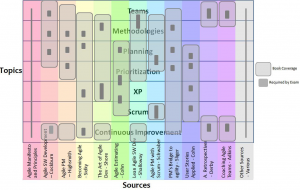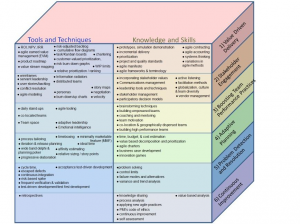Agile Teams
In Agile environment, we are building high-performance teams.
Building a high-performance team is critical to any project’s success. A high performance team has the right team members, is empowered, has built trust, works at a sustainable pace, has consistently high velocity/productivity, takes regular time for reflection to review work, has a team lead that removes any obstacles and provides mentoring and coaching, is self-organized and self-disciplined, and is collocated. Several management techniques can be used to build or foster a high-performance team environment, some techniques include: removing obstacles that slow down a team’s performance, having high expectations of team performance, and coaching and mentoring the team to achieve its best performance. [Coaching Agile Teams. Lyssa Adkins.]
A high-performance agile team is one that is ideally collocated for osmotic communication and face-to-face interaction.
However, collocation isn’t always feasible in today’s multinational environment.
For distributed teams, several practices are available to provide the best form of effective communication in the absence of being collocated: team intranet sites, virtual team rooms, and video conferencing over e-mail when possible. Geographic separation, especially on a world-wide scale, causes the team to consider language and cultural differences, and time zone differences.
[The Art of Agile Development. James Shore.]
High-performance teams differ from low-performance teams with how they deal with conflict.
Conflict is inevitable even for the most experienced agile team.
The difference is that high-performance teams approach conflict with an open mind and as self-organizing often navigate and resolve conflict organically.
[Coaching Agile Teams. Lyssa Adkins.]
Taking the team out to lunch for bonding and trust building. [Agile Retrospectives: Making Good Teams Great. Esther Derby, Diana Larsen, Ken Schwaber.]
Empowered teams
Empowered teams – ones that are self-organizing and know how to solve problems with minimal management involvement – are a cornerstone of the agile methodology.
This is the antithesis to the classic viewpoint of the traditional project manager who is seen as someone that controls all decisions and delegates tasks to a team with little feedback.
An agile team must include all members and stakeholders to make decisions, and make decisions expediently.
Because it is essential that the user/customer be involved with development, it is encouraged that the user/customer is closely integrated with the agile team with collocation/on-site support being ideal.
An agile team feels empowered when it collectively assumes responsibility for the delivery of the product (i.e., taking ownership).
[Coaching Agile Teams. Lyssa Adkins.]
Empowered teams – ones that are self-organizing and know how to solve problems with minimal management involvement – are a cornerstone of the agile methodology.
An agile team feels empowered when it collectively assumes responsibility for the delivery of the product (i.e., taking ownership).
[Coaching Agile Teams. Lyssa Adkins.]
Empowered teams take responsibility of the product and thus have a strong focus on delivering value.
A team that is self-organizing and knows how to solve problems with minimal need for oversight
Empowered teams need minimal management involvement and thus can focus on leading and delivering value instead of being lead
Motivated team
Having a motivated team is essential for any project, regardless of whether it is agile or not.
Motivated teams work together better, have strong productivity, and exceed expectations.
Some simple steps to increase motivation are
1) spending quality time together; where team members get to know one another on a personal level to build a sense of community,
2) providing feedback, mentoring and coaching; where team members are congratulated and thanked on jobs well done and also mentored or coached to improve in skill and capability, and
3) empowerment; where the team is empowered to make many key decisions which, along the way, builds trust and shows that leadership believes in the capabilities of the team.
[The Art of Agile Development. James Shore.]
The best architectures, requirements, and designs emerge from self-organization teams.
Leading
A common misconception in agile is that an agile team does not need a leader.
In fact, all agile teams need a leader, but the way in which the leader leads is fundamentally different than the typical traditional project manager/project leader method.
Some have theorized that this misconception stems from the desired ‘self-organizing’ quality of the agile team.
And although the ‘self-organizing’ agile team is empowered to take ownership and responsibility of the product and make some decisions itself, it nevertheless requires a leader to help provide guidance, mentoring, coaching, problem solving, and decision making.
Some key aspects required of an agile leader include:
empowering team members to decide what standard agile practices and methods it will use;
allowing the team to be self-organized and self-disciplined;
empowering the team members to make decisions collaboratively with the customer;
inspire the team to be innovative and explore new ideas and technology capabilities;
be a champion of and articulate the product vision to team members so it will be motivated to accomplish the overall objective;
remove any obstacles and solve any problems the team may face in its effort;
communicate and endorse the values and principles of agile project management to stakeholders that may be unfamiliar with agile;
ensure that all stakeholders, including business managers and developers, are collaborating effectively; and,
be able to adapt the leadership style to the working environment to ensure that the agile values and principles are effectively upheld.
[The Art of Agile Development. James Shore.]
Coaching and mentoring within teams
Coaching and mentoring within teams can be helpful for nascent agile teams and even for more experienced agile teams.
Coaching and mentoring is the act of helping a person or team improve performance and achieve realistic goals.
Because agile has a value of continuous improvement, coaching and mentoring is not solely for new or immature teams, but experienced ones too where coaching can help achieve higher levels of performance.
The amount of coaching and mentoring an agile team needs is variable.
Some newer teams will need a coach guiding the team nearly all the time while others may need a coach only for particularly challenging situations.
A not uncommon scenario is to have a coach help the team collectively during sprint/iteration planning and then during the iteration help mentor individual team members.
[Coaching Agile Teams. Lyssa Adkins.]
Team motivation
Having a motivated team is essential for any project, regardless of whether it is agile or not.
Motivated teams work together better, have strong productivity, and exceed expectations.
Some simple steps to increase motivation are :
1) spending quality time together; where team members get to know one another on a personal level to build a sense of community,
2) providing feedback, mentoring and coaching; where team members are congratulated and thanked on jobs well done and also mentored or coached to improve in skill and capability, and
3) empowerment; where the team is empowered to make many key decisions which, along the way, builds trust and shows that leadership believes in the capabilities of the team. [The Art of Agile Development. James Shore.]
Globalization, culture, and team diversity / Common language
Scrum emphasizes, in part, the following principles: always have a product you can theoretically ship, speak a common language, and continuously test the product as you build it. [Agile Project Management with Scrum. Ken Schwaber.]
A high-performance agile team is one that is ideally collocated for osmotic communication and face-to-face interaction. However, collocation isn’t always feasible in today’s multinational environment.
For distributed teams, several practices are available to provide the best form of effective communication in the absence of being collocated: team intranet sites, virtual team rooms, and video conferencing over e-mail when possible.
Geographic separation, especially on a world-wide scale, causes the team to consider language and cultural differences, and time zone differences.
[Agile Software Development: The Cooperative Game – 2nd Edition. Alistair Cockburn.]
Changing company culture is typically the most difficult when migrating to an agile framework. [The Art of Agile Development. James Shore.]

